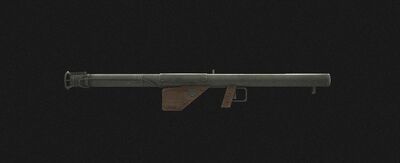| The Bazooka | |
|---|---|

| |
| Manufactured: | 1942 |
| Industry: | Unknown Factory |
| Overall Length: | 1.37 m (54 in) |
| Region of Origin: | United States |
| Action: |
Recoilless rocket anti-tank weapon |
| Type: | recoilless launch + rocket booster |
| Years Active: | 1942-1957 |
Bazooka is the common name for a man-portable recoilless rocket antitank weapon, widely fielded by the U.S. Army. Also referred to as the "Stovepipe", the innovative bazooka was amongst the first-generation of rocket propelled anti-tank weapons used in infantry combat. Featuring a solid rocket motor for propulsion, it allowed for high-explosive anti-tank (HEAT) warheads to be delivered against armored vehicles, machine gun nests, and fortified bunkers at ranges beyond that of a standard thrown grenade or mine. The universally-applied nickname arose from the M1 variant's vague resemblance to the musical instrument called a "bazooka" invented and popularized by 1930s U.S. comedian Bob Burns.
During World War II, German armed forces captured several bazookas in early North African[2] and Eastern Front encounters and soon reverse engineered their own version,[2] increasing the warhead diameter to 8.8 cm (amongst other minor changes) and widely issuing it as the Raketenpanzerbüchse "Panzerschreck" ("Tank terror").[2]
The term "bazooka" continues to be used informally as a genericized term to refer to any shoulder-fired missile weapon.
History[]
In 1942, U.S. Army Colonel Leslie Skinner received the M10 shaped-charge grenade which was capable of stopping German tanks. He tasked Lieutenant Edward Uhl with creating a delivery system for the grenade. Uhl created a small rocket, but needed to protect the firer from the rocket exhaust and aim the weapon. According to Uhl,
"I was walking by this scrap pile, and there was a tube that ... happened to be the same size as the grenade that we were turning into a rocket. I said, That's the answer! Put the tube on a soldier's shoulder with the rocket inside, and away it goes."[1]
Uhl developed the rocket launcher and is known as father of the Bazooka.[1] Development of the M1 prototype took place in Corcoran Hall at The George Washington University in Washington, D.C. with the help of Clarence Hickman who had worked for Goddard. The M1 consisted of a sheet metal tube with a simple wooden stock, hand grips, and sights (replaced by metal in production models), into which the 60.07 mm-diameter (officially designated "M6, 2.36-inch" to avoid confusion with rounds for the 60 mm mortar) rocket grenades were inserted at the rear with trailing electrical leads. The cast steel warhead contained 1.6 lb of Pentolite high explosive. A two-cell dry battery in the wood shoulder rest provided a charge to ignite the rocket when the trigger was pulled; the wires sticking out the back of the round having been connected to two contacts by the assisting loader.